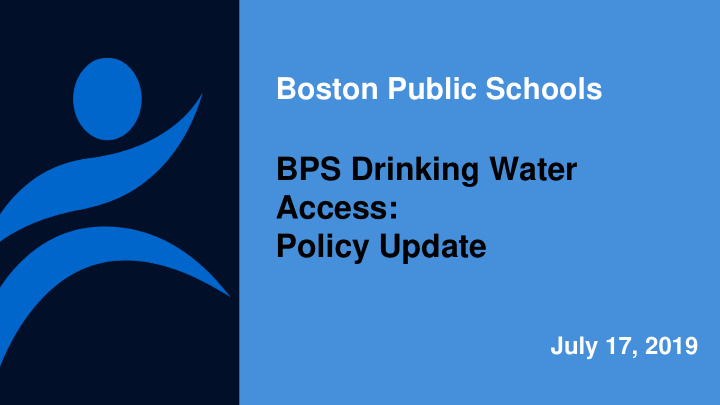



Boston Public Schools BPS Drinking Water Access: Policy Update July 17, 2019
CURRENT BPS DRINKING WATER ACCESS POLICY ● Approved by School Committee in June, 2016 ● The current policy requires: ○ Annual testing of all schools’ drinking water and food preparation units ○ Deactivating all units within a school if any one unit has lead levels above 15 parts per billion ○ Public communications of all test results
PROGRESS SINCE PASSAGE OF THE POLICY ● 17 schools brought online for tap water ● Improved testing results ○ Out of the 698 drinking water and food prep samples tested in 2018, less than 1% of samples had elevated lead levels, representing 3 schools. This is a major improvement from 2016 testing when out of 756 samples, 12% of samples were elevated, representing 58 schools. ● BPS was awarded the 2018 Massachusetts Public Water System Awards: Systems Taking Action to Reduce Lead (STAR-L) Award ● If policy update is approved, MassDEP wants to use it as the model policy for public school systems across the state
NEW FEDERAL AND STATE DRINKING WATER REGULATIONS U.S. Environmental Protection Agency (EPA) and the Mass. Department of Environmental Protection (MassDEP) recently released more stringent drinking water regulations that require school districts to take action on units with lead levels above 1 part per billion (ppb) to reduce those levels to the lowest possible concentrations. Previously, the EPA mandated that no action was necessary at units with lead levels below 20 parts per billion. MassDEP had a more restrictive “action level” at 15 parts per billion.
PROPOSED POLICY UPDATE The BPS Drinking Water Access Policy requires updating to ensure compliance with the recent changes in regulations. In accordance with EPA and MassDEP regulatory changes, BPS will take action on units with lead levels above 1 part per billion (ppb) to reduce those levels to the lowest possible concentrations. BPS will continue to annually test all units used for drinking water and food preparation and deactivate those units with test results above or equal to 15 ppb for lead and/or 1300 ppb for copper.
BENEFITS OF THE PROPOSED POLICY UPDATE Current BPS Drinking Water Access Policy Proposed BPS Drinking Water Access Policy Update Requires updating to reflect new federal and state Compliant with new federal and state drinking water drinking water regulations. Currently non-compliant. regulations. Turns off entire school building for one elevated water Turns off only the elevated water source, not the entire source (this is strongly not recommended by water building (this is strongly recommended by water experts, is experts, is costly, and limits equitable access to cost-effective, and improves equitable water access). drinking water). Previous BPS communications processes Current BPS communications processes No mention of filter use and replacement as this was Includes filter use and replacement because this has since not approved by the state in 2016. been approved by the state. School Committee Policy Policy would contemplate the annual publication of Superintendent’s Circular FMT -20 to reflect the procedural and technical nature of the issue and to enable BPS to update it in the likely event of future regulatory changes. The circular would continue to be listed under the District Wellness Policy with similar BPS circulars.
SUPPORT FOR PROPOSED POLICY UPDATE ● Reviewed and approved by U.S. EPA Region I, MassDEP, BWSC, BPHC, EnviroTrac Ltd., BPS Office of the Legal Advisor, Health & Wellness, Food & Nutrition Services, and Facilities Management ● Letters of support from MassDEP, BWSC, and BPHC ● MassDEP wants to use it as the model drinking water policy for public school systems across the state
QUESTIONS?
APPENDIX
CHANGES TO DRINKING WATER REGULATIONS In October 2018, U.S. EPA released a revised “3Ts for Reducing Lead in Drinking Water in Schools and Child Care Facilities” manual (3Ts now stands for “training, testing and taking action.”) In the Revised 3Ts Manual, EPA states “there is no known safe level of lead for children.” EPA also removed its longstanding Lead Contamination Control Act (LCCA) action level of 20 parts per billion (ppb) for lead in school drinking water and did not set a new action level. Instead of setting an action level, EPA, and subsequently MassDEP, recommends that schools and early education and care programs use the 3Ts Manual to take action on units with the highest lead levels to reduce those levels to the lowest possible concentrations, prioritizing actions based on sample levels. In accordance with guidance from MassDEP, BPS will continue to deactivate any units with lead concentrations of 15 ppb or above.
Recommend
More recommend